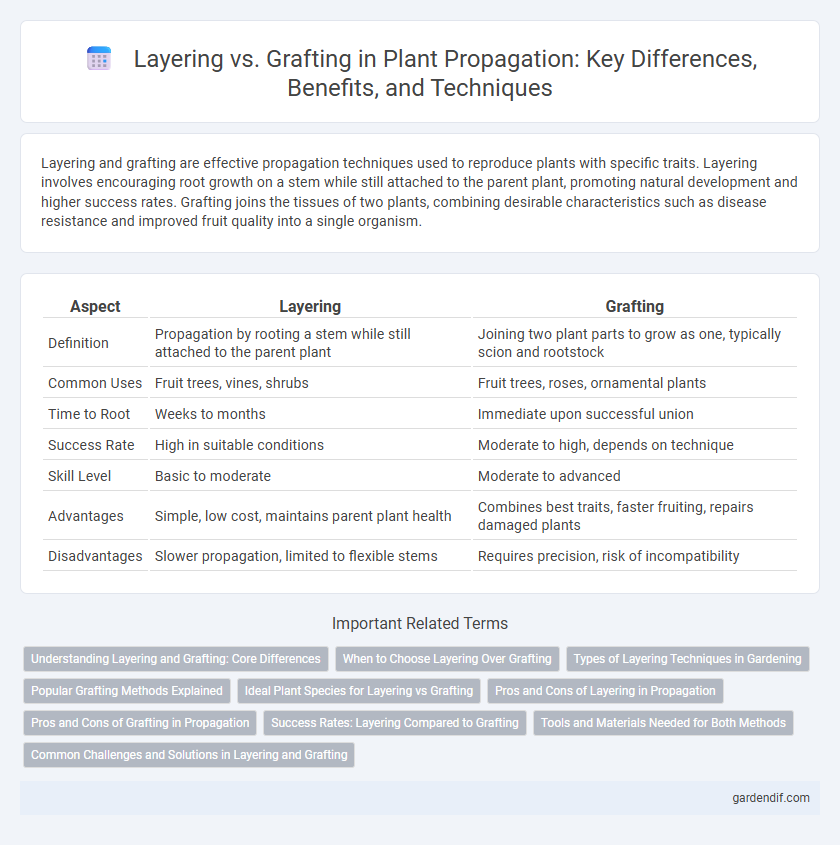
Layering vs Grafting Illustration
Layering and grafting are effective propagation techniques used to reproduce plants with specific traits. Layering involves encouraging root growth on a stem while still attached to the parent plant, promoting natural development and higher success rates. Grafting joins the tissues of two plants, combining desirable characteristics such as disease resistance and improved fruit quality into a single organism.
Table of Comparison
| Aspect | Layering | Grafting |
|---|---|---|
| Definition | Propagation by rooting a stem while still attached to the parent plant | Joining two plant parts to grow as one, typically scion and rootstock |
| Common Uses | Fruit trees, vines, shrubs | Fruit trees, roses, ornamental plants |
| Time to Root | Weeks to months | Immediate upon successful union |
| Success Rate | High in suitable conditions | Moderate to high, depends on technique |
| Skill Level | Basic to moderate | Moderate to advanced |
| Advantages | Simple, low cost, maintains parent plant health | Combines best traits, faster fruiting, repairs damaged plants |
| Disadvantages | Slower propagation, limited to flexible stems | Requires precision, risk of incompatibility |
Understanding Layering and Grafting: Core Differences
Layering involves bending a low branch to the ground and encouraging it to root while still attached to the parent plant, promoting natural root development and higher success rates in some species. Grafting joins a scion from a desired plant onto the rootstock of another, enabling the combination of traits such as disease resistance and fruit quality. The core difference lies in layering's reliance on a single plant for multiplication, while grafting merges two plants to enhance characteristics and adaptability.
When to Choose Layering Over Grafting
Layering is the preferred propagation method when working with plants that root easily from stems, such as fruit trees and shrubs, enabling new plants to develop while still attached to the parent. It is ideal for species where graft compatibility is uncertain or difficult, reducing the risk of propagation failure common with grafting. Layering is also chosen for preserving the exact genetic makeup of the parent plant, especially when propagating difficult-to-graft cultivars or repairing damaged root systems.
Types of Layering Techniques in Gardening
Simple layering involves bending a low-growing stem to the ground and covering a portion with soil, encouraging roots to develop while remaining attached to the parent plant. Mound layering is used for shrubs by cutting back the plant to encourage numerous shoots, which are then buried under a mound of soil to root independently. Serpentine layering consists of alternating sections of a long stem being buried and exposed, promoting multiple root formations along the stem for propagation.
Popular Grafting Methods Explained
Popular grafting methods include whip and tongue grafting, cleft grafting, and budding techniques such as T-budding and patch budding. Whip and tongue grafting provides strong cambial contact for woody plants, while cleft grafting is effective for joining larger rootstocks and scions. Budding methods are highly favored in fruit tree propagation due to ease of technique and rapid union formation.
Ideal Plant Species for Layering vs Grafting
Ideal plant species for layering include fruit trees like figs, raspberries, and magnolias due to their flexible stems and ability to root while attached to the parent plant. Grafting is better suited for woody plants such as apples, cherries, and roses, where combining rootstock and scion enhances disease resistance and fruit quality. Understanding these species-specific traits ensures successful propagation outcomes for both layering and grafting methods.
Pros and Cons of Layering in Propagation
Layering in propagation offers advantages such as promoting root development while the stem is still attached to the parent plant, enhancing survival rates and reducing transplant shock. This method requires less specialized skill and fewer resources compared to grafting, making it accessible for many gardeners. However, layering can be slow, often taking several months to a year for roots to establish, and is limited to certain plant species and growth habits.
Pros and Cons of Grafting in Propagation
Grafting in propagation offers the advantage of combining desirable traits from two plants, such as disease resistance and superior fruit quality, resulting in faster maturity compared to layering. It enables the repair of damaged plants and the production of clones with uniform characteristics, though it requires skilled labor and can be susceptible to graft incompatibility. Despite higher initial costs and potential graft failure, grafting remains a preferred method for propagating woody plants and fruit trees where maintaining genetic fidelity is essential.
Success Rates: Layering Compared to Grafting
Layering typically achieves success rates between 70% and 90%, as it encourages root formation while the branch remains attached to the parent plant, ensuring nutrient supply. Grafting often exceeds a 90% success rate due to precise tissue compatibility and controlled environmental conditions during union. Factors such as plant species, technique skill, and environmental control significantly influence the comparative success rates between layering and grafting.
Tools and Materials Needed for Both Methods
Layering requires flexible ties, rooting hormone, a sharp knife or pruning shears, and a pot or soil for burying the stem. Grafting calls for a grafting knife, grafting tape or rubber bands, rootstock and scion materials, and sealing wax or grafting compound to protect the union. Both methods benefit from clean, sterilized tools to prevent infection and promote successful propagation.
Common Challenges and Solutions in Layering and Grafting
Common challenges in layering include poor callus formation and root development due to inadequate moisture or improper timing, while grafting often faces issues like incompatible scion and rootstock or weak graft union. Solutions for layering involve ensuring optimal humidity, selecting appropriate plant species, and carefully monitoring the layering process to promote root growth. For grafting, using compatible plant varieties, precise alignment of cambium layers, and securing graft unions tightly improve success rates and plant vigor.
Layering vs Grafting Infographic

 gardendif.com
gardendif.com